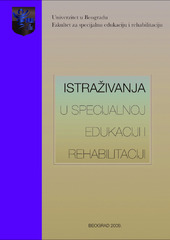Prikaz osnovnih podataka o dokumentu
Prenatalna dijagnoza daun sindroma – savremeni pristup
Prenatal diagnosis of down syndrome – modern approach
| dc.contributor | Matejić-Đuričić, Zorica | |
| dc.creator | Maksić, Jasmina | |
| dc.creator | Ninković, Dragan | |
| dc.date.accessioned | 2022-05-11T09:38:20Z | |
| dc.date.available | 2022-05-11T09:38:20Z | |
| dc.date.issued | 2009 | |
| dc.identifier.isbn | 978-86-80113-84-5 | |
| dc.identifier.uri | http://rfasper.fasper.bg.ac.rs/handle/123456789/4509 | |
| dc.description.abstract | Daun sindrom (DS) ili trizomija hromozoma 21, je načešći oblik mentalne zaostalosti praćen specitičnim telesnim osobinama. Odavno je pokazana veza godina starosti majke i rađanja dece sa ovom trizomijom, pa je praksa da se invazivne dijagnostičke procedure savetuju majkama starije životne dobi. Međutim, učešće starijih majki u rađanju dece sa DS je 30%, te se sve veća pažnja usmerava mlađim majkama, iako je njihov rizik za rađanje fetusa sa DS niži. Ipak, nepotrebno je svaku trudnicu izlagati invazivnim dijagnostičkim procedurama, pa se tragalo za novim načinima izdvajanja visoko rizičnih trudnoća. Kasnih osamdesetih godina dvadesetog veka razvio se novi neinvazivni metod skriniga koji pored godina majke uzima u obzir i koncentracije različitih fetoplacentarnih produkata u cirkulaciji majke- AFP, hCG, nE3 i inhibin A. Ovaj skrining test u drugom trimestru trudnoće može identifikovati 70% fetusa sa trizomijom 21. Tokom devedesetih godina dvadesetog veka, uveden je skrining trizomije 21 koji uključuje starost majke i debljinu nuhalne translucencije fetusa (NT) u prvom trimestru trudnoće. Ovaj metod identifikuje oko 75% fetusa sa DS. Ako se ovaj test kombinuje sa biohemijskim skriningom beta-hCG-a i PAPP-A, može se identifikovati 85-90% fetusa sa DS. 2001 godine ustanovljeno je da kod 60-70% fetusa sa trizomijom 21, nije moguće ultrazvučno videti nosnu kost između 11 i 13+6 nedelja gestacije. Ovo saznanje, uz prethodni skrining u prvom trimestru, povećava procenat detekcije trizomije 21 na 95-97%, uz 5% lažno pozitivnih rezultata. Otkriće i primena ovih skrining testova omogućila je da se u populaciji trudnica izdvoje visoko rizične trudnoće i smanji broj invazivnih procedura. S obzirom da skrining testovi mogu samo ukazati na visoko rizične trudnoće, i dalje invazivne dijagnostičke metode, biopsija horionskih resica i amniocenteza, ostaju nezamenljive u dijagnostici Daun sindroma kod fetusa. | sr |
| dc.description.abstract | Down syndrome or chromosome 21 trisomy, is the most common form of mental retardation associated with specific physical features. Since the relationship between maternal age and the incidence of this syndrome has been proven long ago, common approach to older pregnant women is to advise invasive diagnostic procedures. However, older mothers are responsible for 30% of children with Down syndrome, so now more attention is focused on younger mothers although they have lower risk of having a fetus with Down syndrome. Nevertheless, it is not necessary to expose every pregnant woman to invasive diagnostic procedures, so new ways of determining high risk pregnancies were looked for. In late eighties of 20th century new non-invasive screening method was found. Besides maternal age, it took into consideration the concentration of various feto-placental products in the bloodstream of mother – AFP, hCG, nE3 and inhibin A. This screening test can identify 70% of fetuses with trisomy 21 in the second trimester. During nineties of the last century, a new screening method was introduced – it correlated maternal age and the thickness of fetal nuchal translucence (NT) in the first trimester. This method can identify about 75% of fetuses with Down syndrome. If this test is combined with biochemical screening of beta-hCG and PAPP they can uncover 85-90% of Down syndrome fetuses. In the year of 2001 it was found out that it was not possible to see the nasal bone by ultrasound between 11 and 13+6 weeks of gestation. This information along with screening in the first trimester, increases the detection of trisomy 21 to 95-97%, which represents a false –positive rate of 5%. These methods have enabled us to identify high risk pregnancies and reduce the number of invasive procedures. Since screening tests can only point to high risk pregnancies, invasive diagnostic methods like biopsy of chorionic villi and amniocentesis remain valuable in the diagnosis of Down syndrome in fetus. | sr |
| dc.language.iso | sr | sr |
| dc.publisher | Univerzitet u Beogradu – Fakultet za specijalnu edukaciju i rehabilitaciju/ University of Belgrade – Faculty of Special Education and Rehabilitation | sr |
| dc.rights | openAccess | sr |
| dc.rights.uri | https://creativecommons.org/licenses/by-sa/4.0/ | |
| dc.source | Zbornik radova - „Istraživanja u specijalnoj edukaciji i rehabilitaciji / Research in Special Education and Rehabilitation“,Beograd / Belgrade,2009 | sr |
| dc.subject | Daun sindrom | sr |
| dc.subject | prenatalna dijagnoza | sr |
| dc.subject | skrining test u prvom trimestru | sr |
| dc.subject | skrining test u drugom trimestru | sr |
| dc.subject | Down syndrome | sr |
| dc.subject | prenatal diagnosis | sr |
| dc.subject | first trimester screening test | sr |
| dc.subject | second trimester screening test | sr |
| dc.title | Prenatalna dijagnoza daun sindroma – savremeni pristup | sr |
| dc.title | Prenatal diagnosis of down syndrome – modern approach | sr |
| dc.type | conferenceObject | sr |
| dc.rights.license | BY-SA | sr |
| dc.citation.epage | 184 | |
| dc.citation.spage | 171 | |
| dc.identifier.fulltext | http://rfasper.fasper.bg.ac.rs/bitstream/id/7742/Untitled14.pdf | |
| dc.identifier.rcub | https://hdl.handle.net/21.15107/rcub_rfasper_4509 | |
| dc.type.version | publishedVersion | sr |


